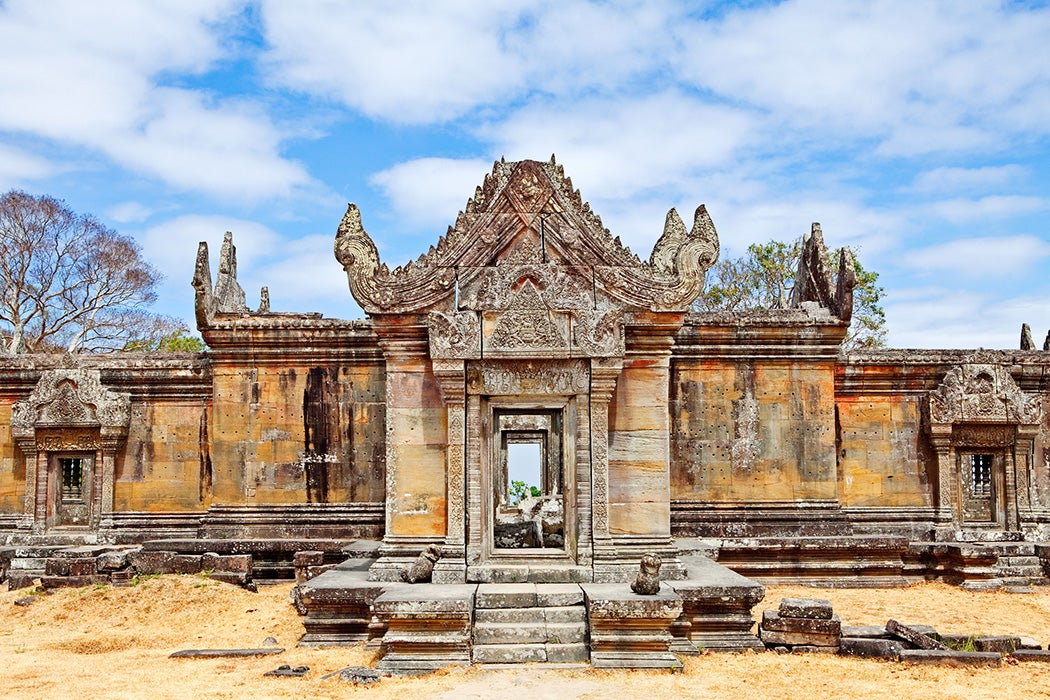When thinking of architecture of the Khmer Empire, which once ruled much of Southeast Asia, Angkor Wat is usually the first to come to mind. But perhaps you’ve heard of Preah Vihear? This small Hindu temple in the Dângrêk Mountains of northern Cambodia isn’t on the main tourist trail, yet it’s found itself at the center of international news on many occasions: it’s a focal point in an on-going border dispute between Cambodia and Thailand.
Preah Vihear was built primarily during the golden period of the Khmer Empire, in the eleventh and twelfth centuries, though there’s evidence of construction at the temple’s location at the edge of the Khmer kingdom that dates back to the ninth century.
Journalist Brendan Borrell describes Preah Vihar as “a series of buildings arrayed along a 2,600-foot-long central causeway that proceeds dramatically to the edge of a cliff. The complex is meant to represent Mount Meru, the home of Shiva and other Hindu gods.” According to Eileen Lustig, Damian Evans, and Ngaire Richards, Sanskrit and Old Khmer inscriptions, dating from the sixth to fourteenth centuries and found across Southeast Asia,
The Khmer Empire and its “elaborate bureaucracy” would fall, but not until the fifteenth century.
The modern debate over who “owns” Preah Vihear is more recent, dating to the early twentieth century. The French protectorate of Cambodia was established in 1863 after a request from the Cambodian king, Norodom, partially due to fears of the neighboring Kingdom of Siam (present-day Thailand). A series of Franco-Siam treaties between 1904 to 1907 sought to clarify the boundaries between the French protectorate and Siamese territory. Maps of the border region were produced by the French and published in 1908. But, as cultural anthropologist Sang Kook Lee writes,
[i]t is widely known among South East Asianists that current boundaries in the region reflect Western colonial influences. It is a common understanding that before the intervention of Western powers, South East Asians upheld the idea that a mutually exclusive boundary did not exist.
The process the French government used to strictly define the border would have been new to the Kingdom of Siam (indeed, Lee argues that rigid boundaries were a relatively new phenomenon in European history as well, appearing only in the seventeenth century). In the published maps, Borrell explains, the
French surveyors sketched a line that was supposed to follow the watershed boundary, a line that separates the river basins between the two countries. Near Preah Vihear, the border follows the edge of a cliff but diverges from the cliff near the temple complex so that it is included in Cambodian territory.
The adoption of these maps would come back to haunt Thailand decades later. Lee explains that “Siam was destined to comply with this enforcement, yet the lack of mapping technologies on the part of the Siamese meant that French officers drew up the geo-body, leading to important future repercussions involving Preah Vihear.” In other words, the border that edged around Preah Vihear, and to which Thailand would be legally bound, was delineated entirely by French mapping decisions.
After Cambodia gained its independence from France in 1953, Thailand placed troops at Preah Vihear to reclaim the temples as its own. Cambodia filed a complaint with the International Court of Justice (ICJ), arguing that Thailand was illegally occupying part of its territory. In 1962, the ICJ ruled in Cambodia’s favor, rejecting Thailand’s claim, specifically noting that Thailand had previously accepted the territorial survey maps produced by the French that placed Preah Vihear within Cambodian territory. And while an argument can be made about the unusual border deviation to place Preah Vihear within Cambodian territory, Panchali Saikia points out that a“[it] is argued that Cambodia has stronger competing claims over Thailand as the origin of the temple belongs to the Khmer empires.” This ruling wouldn’t be the end of the dispute, as Preah Vihear became part of political and nationalist agendas in both countries.
Weekly Newsletter
In the early 2000s, Cambodia initiated the process to make Preah Vihear a UNESCO World Heritage site. Borrell explains that it was “hoped that Preah Vihear’s listing will be another step toward prosperity for Cambodia. The site would provide a destination in the less-developed northern part of the country, which might entice some of the tourists who visit Angkor Wat to extend their stays.” (Angkor Wat became a UNESCO World Heritage site in 1992.) When Thailand’s Minister of Foreign Affairs, Noppadon Pattama, put his support behind the nomination in May 2008, it upset many in Thailand. He was forced to resign just two months later, in July, the same month UNESCO made Preah Vihear a World Heritage site.
Another round of violent border clashes broke out early 2011, lasting from February to April. In 2013, the topic of Preah Vihear returned to the ICJ. After the violence of 2011, Cambodia sought further clarifications on the 1953 ruling. This time the ICJ not only reinforced Cambodia’s ownership of Preah Vihear, it went further, giving Cambodia rights to part of the land around the temple and instructing Thailand to withdraw from the vicinity.
Preah Vihear has been relatively calm since 2013. It remains to be seen if the ownership debate over the site officially come to an end or is merely on pause.
Teaching Tips
- UN Secretary-General Papers: Ban Ki-moon, shared via JSTOR by the City College of New York, include the 2008 “Note to the Secretary-General: Cambodia/Thailand: Border Tensions” and the brief 2011 “Letter from the Secretary-General: World Heritage Site.”
- The UNESCO World Heritage Convention site includes maps, images, and nomination files for the Preah Vihear site.
- The International Court of Justice ruling pages for Temple of Preah Vihear (Cambodia v. Thailand) (1961–1962) and the
Request for Interpretation of the Judgment of 15 June 1962 in the Case concerning the Temple of Preah Vihear (Cambodia v. Thailand) (2011–2013) are online.







